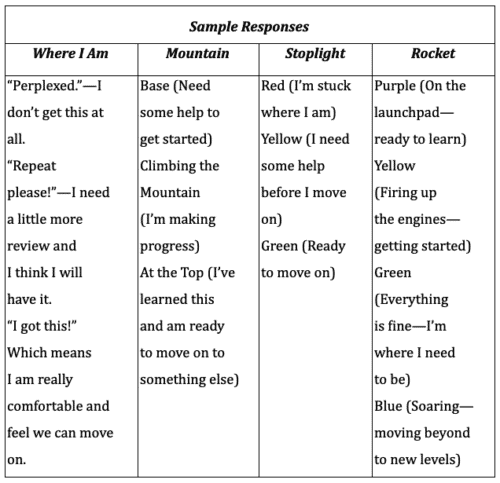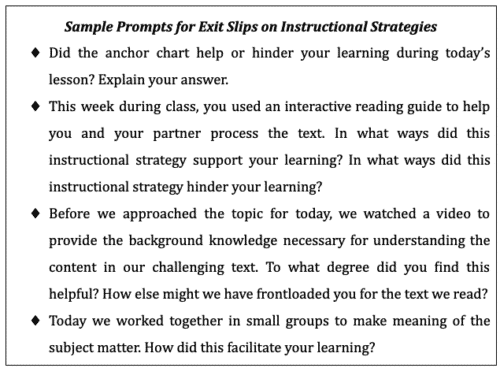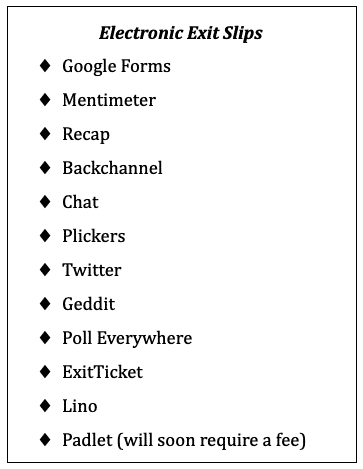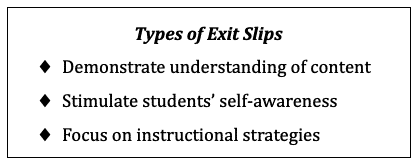Table of Contents
Exit slips are a popular strategy for receiving instant feedback on a student’s level of mastery. Unfortunately, we sometimes fall into the trap of simply asking students what they learned and what they still want to learn. Although that can be effective, exit slips can provide more information.
There are three functions of exit slips, each of which supports different aspects of your instruction.
 Demonstrate Understanding of Content
Demonstrate Understanding of Content
Probably the most common use of exit slips is for students to explain what they learned during the lesson. Although you can simply ask them to write down something they learned, you can also extend that to ask for a higher level of understanding. At the most basic level, simply ask the students, “What are your three take-aways from today’s lesson?” It’s quite revealing to read what your students actually heard you say that day. You can quickly address misconceptions or reemphasize missed points the next day.
Stimulate Students’ Self-Awareness
In these exit slips, students judge how well they understand the content. For example, you might ask students to rank themselves on a scale of 1 to 4: 4—I can teach this to another student; 3—I feel comfortable working on my own but may need to use another resource to help me; 2—I understand somewhat but need a different explanation; 1—clueless. Ask students, “how would you rate your understanding of what we discussed in class today?” You might place a laminated poster by your door. On the poster, use a picture of a stoplight, mountain or another symbol that is relevant to students. Then pose the question. For example, “How comfortable do you feel with using proofs to confirm a theorem?” Or “How confident are you in your ability to explain the difference between a chemical change and a physical change to another student? Write your name on a sticky note and place it on or near the term or picture that matches your comfort level.” If you would like students’ responses to be confidential, have them write their choice on a notecard and place it in a box near the door.

Another option is to use A Bump in the Road. With a bump in the road, students reflect on their learning and identify two to four points where they hit bumps in the road, or struggles. Then they partner with another student to see if they can work their way through their struggle.
Focus on Instructional Strategies
When you use an exit slip in this manner, it gives students an opportunity to provide feedback on the effectiveness of specific instructional strategies used to support their learning. This type of exit strategy is best implemented weekly.

No matter what type of exit slip you are using, you’ll want to find a way to manage the information. With today’s technology, there is a variety of ways to collect exit slip information from your students. With any mobile device, students can access a digital platform and immediately push answers out to the teacher, who then has the ability to display the class’s thinking as a whole on the screen or choose a select few to further discuss.

A Final Note
Exit slips are commonly used and can be an effective instructional tool. However, it’s important to consider why you are using exit slips and whether your prompt matches that purpose.
- eSchool News – 8 informal assessments to pinpoint what your students need
- Education Week – Teaching Secrets: Start With the Exit Ticket
- Teacher Magazine – Sharing good practice: Gonski and assessment of student learning




